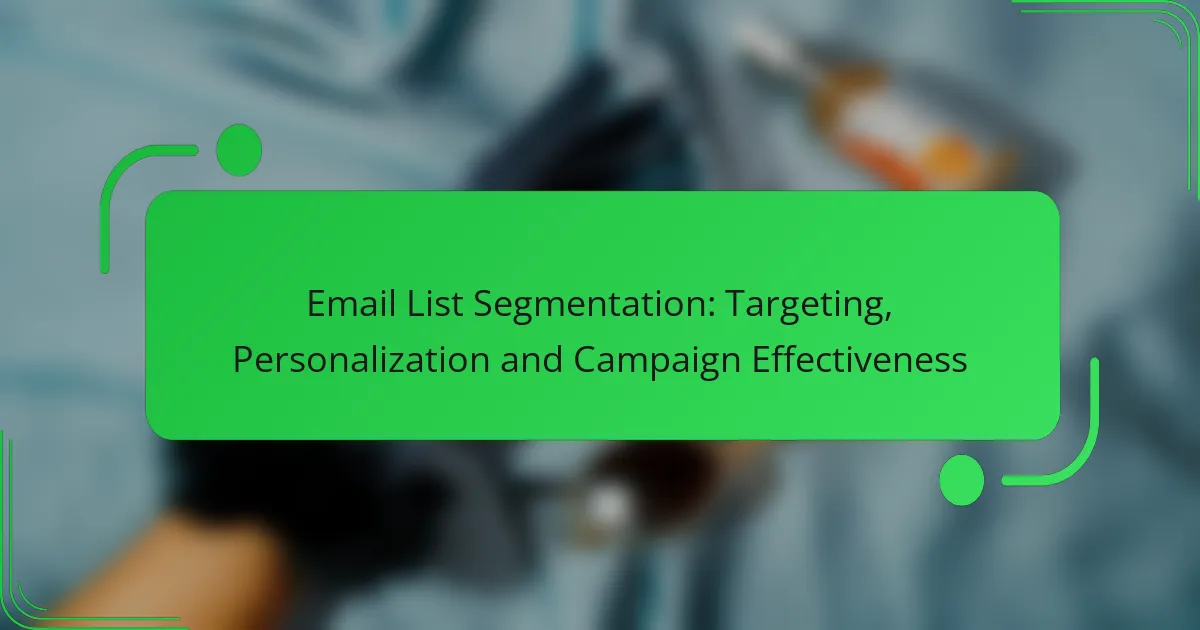A/B testing is a powerful strategy for optimizing email campaigns, enabling marketers to compare different email versions and identify which one resonates best with their audience. By analyzing key performance metrics, businesses can make informed decisions that enhance engagement and drive higher returns on investment.

How can A/B testing improve email campaign performance?
A/B testing can significantly enhance email campaign performance by allowing marketers to compare different versions of emails to determine which one resonates better with the audience. By analyzing metrics such as open rates, click-through rates, and conversion rates, businesses can make data-driven decisions that lead to improved engagement and higher returns on investment.
Increased open rates
Improving open rates is crucial for the success of any email campaign. A/B testing can help identify which subject lines, sender names, or preview texts attract more recipients to open the email. For instance, testing variations of subject lines with different lengths or emotional triggers can lead to increases in open rates by tens of percent.
To maximize open rates, consider testing elements such as urgency (e.g., “Last chance to save!”) versus curiosity (e.g., “You won’t believe this offer!”). Regularly analyzing the results can help refine your approach over time.
Higher click-through rates
Click-through rates (CTR) measure how effectively your email content drives recipients to take action. A/B testing can reveal which calls to action (CTAs), images, or content layouts lead to higher engagement. For example, testing a button versus a text link can provide insights into what your audience prefers.
To boost CTR, focus on clear and compelling CTAs. Use contrasting colors for buttons and ensure they are prominently placed within the email. Regularly reviewing click data will help you understand what resonates with your audience.
Enhanced conversion rates
Conversion rates indicate the percentage of recipients who complete a desired action, such as making a purchase or signing up for a newsletter. A/B testing can help identify which email elements drive conversions by comparing different offers, layouts, or personalization strategies. For instance, testing a discount offer against a free trial can help determine which option yields better results.
To improve conversion rates, ensure that your emails are targeted and relevant to your audience. Use segmentation to tailor messages based on user behavior or preferences. Additionally, consider testing follow-up emails to re-engage recipients who did not convert initially.

What are the best practices for A/B testing in email campaigns?
Effective A/B testing in email campaigns involves systematic experimentation to identify which elements drive better engagement and conversion rates. By following best practices, marketers can optimize their emails for improved performance and lead generation.
Define clear objectives
Establishing clear objectives is crucial for successful A/B testing. Determine what specific outcome you want to achieve, such as increasing open rates, click-through rates, or conversions. This focus will guide your testing process and help you measure success accurately.
For instance, if your goal is to boost click-through rates, you might test different call-to-action (CTA) buttons or email layouts. Ensure that your objectives are measurable and relevant to your overall marketing strategy.
Segment your audience
Segmenting your audience allows for more tailored A/B tests, leading to more meaningful results. By dividing your email list into groups based on demographics, behaviors, or interests, you can test variations that resonate with specific segments.
For example, you might send one version of an email to younger subscribers and another to older ones. This approach helps identify which elements perform best for different audience segments, enhancing overall engagement.
Test one variable at a time
To accurately assess the impact of changes, test only one variable at a time in your A/B tests. This could be the subject line, email design, or content type. By isolating variables, you can pinpoint what specifically drives performance changes.
For instance, if you change both the subject line and the CTA in the same test, it becomes difficult to determine which change influenced the results. Stick to a single variable for each test to ensure clarity in your findings and to make data-driven decisions.

Which tools are effective for A/B testing email campaigns?
Effective A/B testing tools for email campaigns help marketers optimize their messaging, design, and overall engagement. Popular options include Mailchimp, Optimizely, and HubSpot, each offering unique features and capabilities tailored for different needs.
Mailchimp
Mailchimp is a widely used email marketing platform that offers built-in A/B testing features. Users can test various elements such as subject lines, content, and send times to determine what resonates best with their audience.
To conduct an A/B test in Mailchimp, simply create multiple versions of your email and select the metrics you want to analyze, like open rates or click-through rates. This tool is particularly user-friendly for small to medium-sized businesses looking to enhance their email performance.
Optimizely
Optimizely is known for its robust experimentation capabilities, extending beyond email to web and mobile applications. It allows marketers to test different email designs and content variations to optimize user engagement.
When using Optimizely for email A/B testing, you can segment your audience and analyze results in real-time. This platform is ideal for larger organizations that require advanced analytics and integration with other marketing tools.
HubSpot
HubSpot provides a comprehensive marketing automation platform that includes A/B testing for emails. Users can easily create variations of their emails and track performance metrics to identify the most effective elements.
HubSpot’s A/B testing feature allows you to test subject lines, content, and CTAs, making it a versatile choice for businesses of all sizes. Additionally, the platform offers detailed reporting, helping marketers make data-driven decisions to improve future campaigns.

What metrics should be tracked during A/B testing?
During A/B testing, key metrics to track include open rates, click-through rates, and conversion rates. These metrics provide insights into how well your email campaigns are performing and where improvements can be made.
Open rates
Open rates measure the percentage of recipients who open your email. A higher open rate indicates that your subject line and sender name are effective. Aim for open rates in the range of 15% to 30%, depending on your industry and audience.
To improve open rates, consider A/B testing different subject lines, send times, and personalization techniques. Avoid spammy language and ensure your emails are mobile-friendly to enhance visibility.
Click-through rates
Click-through rates (CTR) indicate the percentage of recipients who click on links within your email. This metric is crucial for assessing the effectiveness of your content and call-to-action (CTA). A good CTR typically falls between 2% and 5% for most industries.
To boost CTR, experiment with different CTAs, button placements, and email layouts. Make sure your links are clear and compelling, and consider segmenting your audience to tailor content more effectively.
Conversion rates
Conversion rates reflect the percentage of recipients who complete a desired action, such as making a purchase or signing up for a newsletter. This metric is vital for measuring the overall success of your email campaign. Conversion rates can vary widely, but a range of 1% to 3% is common for many campaigns.
To enhance conversion rates, ensure that your landing pages are optimized for user experience and align with the email content. Test different offers, incentives, and follow-up strategies to find what resonates best with your audience.

How to analyze A/B testing results?
Analyzing A/B testing results involves evaluating the performance of different variations to determine which one yields better outcomes. Key aspects include understanding statistical significance, utilizing data visualization techniques, and deriving actionable insights from the findings.
Statistical significance
Statistical significance helps determine if the results from your A/B tests are due to chance or if they reflect a true difference in performance. A common threshold for significance is a p-value of less than 0.05, indicating a less than 5% probability that the observed results occurred randomly.
To achieve reliable results, ensure your sample size is adequate. A larger sample size increases the power of your test, reducing the likelihood of Type I and Type II errors. Use online calculators to estimate the required sample size based on expected conversion rates.
Data visualization
Data visualization is crucial for interpreting A/B testing results effectively. Graphs and charts can illustrate differences in performance metrics, making it easier to identify trends and patterns. Common visualization tools include bar charts, line graphs, and pie charts.
When presenting your results, focus on clear visual comparisons between variations. Highlight key metrics such as conversion rates, click-through rates, and revenue per email to provide a comprehensive overview of performance differences.
Actionable insights
Actionable insights are the conclusions drawn from A/B testing that can inform future marketing strategies. After analyzing the results, identify which variation performed best and consider the underlying reasons for its success or failure.
To translate insights into action, create a checklist of changes to implement based on your findings. For example, if a specific subject line led to higher open rates, consider using similar language in future campaigns. Avoid making decisions based solely on one test; instead, look for consistent patterns across multiple tests to validate your conclusions.

What are common pitfalls in A/B testing?
Common pitfalls in A/B testing can significantly skew results and lead to poor decision-making. Understanding these pitfalls is crucial for optimizing email campaigns and generating leads effectively.
Testing too many variables
Testing too many variables at once can complicate the analysis and dilute the impact of each change. For instance, if you alter the subject line, email content, and call-to-action simultaneously, it becomes challenging to determine which factor influenced the results.
To avoid this, focus on one variable at a time. This approach allows for clearer insights and more actionable data. A good practice is to prioritize changes based on their potential impact and test them sequentially.
Insufficient sample size
Having an insufficient sample size can lead to unreliable results in A/B testing. If too few recipients receive the emails, the data may not accurately represent the target audience’s behavior, leading to misguided conclusions.
As a rule of thumb, aim for a sample size that is large enough to achieve statistical significance, typically in the low hundreds to thousands, depending on your overall audience size. This ensures that the results are more reliable and reflective of broader trends.


